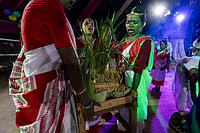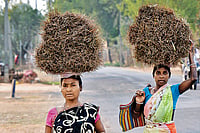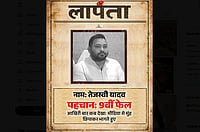When 200 tribal gram sabha heads from Chaibasa in Jharkhand’s West Singhbhum district met on September 13, their minds weighed heavy with concern.
The occasion was a meeting of the Manki Munda Association at Chaibasa’s Gurudwara road which was organised to discuss how the aggressive pursuit of Uniform Civil Code (UCC) and One Nation One Election (ONOE) agendas by the Centre could place the future of tribals, their identity and their conservative self-government system guaranteed under the Constitution’s Fifth Schedule in peril.
The growing buzz around the UCC and ONOE has made 51-year-old Kalicharan Birua, deputy chairman of the Association, anxious.
“Sometimes, it is one country, one legislation, sometimes one country, one election. There is no scope for diversity. Later, they may even maintain that our Manki, Munda, Pahra Raja or Gram Sabha too will be irrelevant. Only their system will function. Why should we follow the system of those who do not follow our system or custom? We are worried that in the name of law and legislation, they may put an end to our tribal area, our tradition, our freedom and conservative (traditional) system,” Birua said.
Munda, Manki, Tana Bhagat, Pahra Raja, Majhi Pargana are designations of indigenous leaders in the tribal landscape of Jharkhand, which is rooted in cultural tradition. Munda is a village-level official, inferior to the Manki, who looks after several villages. If Munda is unable to resolve any issue, it is bumped up to the Manki. In the same manner, a Pahra Raja heads a bunch of villages and several village gram sabhas report to him.
For the last 29 years, Kalicharan has been the village head of Pilka gram sabha in Manjhari located in West Singbhum district. He too is worried about the future of the traditional tribal self-governance system. The government, he says, can facilitate its own system in the areas governed by the Fifth Schedule, but without tampering with the Panchayats (Extension to Scheduled Areas) Act, 1996, also referred to as the PESA Act. The Act ensures self-governance through traditional gram sabhas for people living in the Scheduled Areas of India, which are identified by the Constitution’s Fifth Schedule.
As per the Indian Constitution, tribal areas in ten states namely Jharkhand, Odisha, Chhattisgarh, Madhya Pradesh, Rajasthan, Gujarat, Maharashtra, Himachal Pradesh, Telangana and Andhra Pradesh are governed by the Fifth Schedule, while tribal dominated states in the North East Assam, Meghalaya, Tripura and Mizoram are covered by the Constitution’s Sixth Schedule.
According to the 2011 census, Jharkhand alone accounts for a tribal population of 87 lakh. Fourteen out of 24 districts of Jharkhand fully come under the Fifth Schedule, where more than 50 per cent of the population in 12,164 villages is classified as tribal.
As per the Constitution, tribal communities possess a constitutional right to self-governance within their villages. In 1996, the PESA was enacted to protect this right. PESA grants significant autonomy to villages coming under the Fifth Schedule and empowers the gram sabha, the village assembly.
PESA confers ownership rights over minor forest produce, irrigation, and minor minerals to these villages. Importantly, no government policy can be implemented in such villages and no development work can commence without prior permission and approval from the gram sabha. Even entry into the village requires the consent of the sabha. This legislation is believed to be instrumental in preserving the self-governing traditions and rights of tribal communities.
But amid the rhetoric that surrounded the revocation of Article 370 in Jammu and Kashmir, and the buzz now about the implementation of the UCC and ONOE, has Xavier Kujur, an expert on tribal affairs, worried.
“Much like Article 370, the next potential step may involve abolishing the Fifth and Sixth Schedules. This is why our discussions on the UCC and ONOE are underway. Doing away with established multi-tier elections, including those of the district autonomous councils, especially in the North Eastern states, is a formidable challenge and likely to encounter resistance. India’s strength lies in its diversity, making it impractical to impose a single universal law or provision,” Kujur said.
In terms of constitutional autonomy in Indian tribal regions, the states in the North East, under the Sixth Schedule, hold more substantial autonomy than those under the Fifth Schedule. Ladakh, now a Union Territory, aspires to join the Sixth Schedule states, driven by its over 90 per cent tribal population. However, the Central Government hasn’t acceded to this request yet. Assam, Meghalaya, Tripura, and Mizoram, all of which are part of Schedule 244, come under the Sixth Schedule, granting them special administrative provisions. These areas have Autonomous District Councils with legislative, judicial, and administrative autonomy within the state, implementing state and central laws with specific modifications.
But new and aggressive political jargon dished out ahead of the 2024 Lok Sabha polls, calling for homogenisation of major laws across India, makes former Assam MLA and tribal activist Holiram Terang agitated about the future of India’s diversity, unique languages, cultures, traditions, and landscapes.
“Will we erase these distinctions and the tribal identity? Discussions now centre on ONOE, but it could also extend to ‘one language and one religion. This would lead to side-lining of North-Eastern languages in favour of those from Uttar Pradesh and impose RSS Hindutva as the universal faith,” Terang said, adding that their Autonomous District Council elections are dominated by issues related to tribals, but if elections are held pan-India, only issues raised by national parties would dominate.
“The independent power and function of the Autonomous District Council would cease to exist,” he further said.
However, Ramvichar Netam, a prominent BJP tribal representative in Chhattisgarh and former Home Minister of the state, views ONOE as a crucial step towards the country’s economic growth. “ONOE doesn’t diminish tribal rights under the Fifth and Sixth Schedules. Panchayat and gram sabha elections will persist. Tribal communities are being misinformed. The concept unifies Rajya Sabha and Lok Sabha elections, which is essential for development, saving both time and money. Separate elections would strain resources, potentially impoverishing the nation,” he said.
Sudhir Pal, a respected authority on the Fifth and Sixth Schedules and an author of a book on the subject, disagrees with Ramvichar. “Will the Lok Sabha, assembly elections, elections of the three tiers of Panchayati Raj and municipalities, election of gram sabhas under the Fifth Schedule areas, elections to the Autonomous District Council under the Sixth Schedule in the North East, be held under the ONOE norm? All those people who are advocating this, are not aware of the complexities involved.
“If this does happen, it will face maximum opposition from North Eastern and Fifth Schedule states, as both these states have very different self-government systems as compared to others,” he said, while lamenting that tribal rights granted during the British era had gradually diminished post-independence through new laws.
Autonomy for tribal states under the Fifth and Sixth Schedules dates back to British rule when these regions were designated as excluded areas. The Fifth Schedule states were partially excluded or partially restricted, while the Sixth Schedule states were fully excluded or fully restricted.
According to Kujur, even the mighty British Empire, which had a track record of defeating kings and emperors had to acknowledge tribal areas as excluded territories, because they encountered persistent resistance in these areas from tribals, who took the battle to the colonisers.
“The tribal population fiercely defended their forests and lands, leading to numerous uprisings, including the Coal rebellion, Santhal rebellion, Tamar rebellion, Birsa revolt and land revolt in the Jharkhand area. Failing to establish control, the British eventually reached agreements with the tribal communities, recognising their self-governance systems and land rights. This led to the classification of tribal areas as partially excluded and fully excluded regions. Following independence, the Indian Constitution officially designated these as Fifth and Sixth Schedule areas,” Kujur said.
In a nation defined by its diversity, the cloud of pan-India homogenisation of laws has triggered a feeling of uncertainty in Jharkhand and India’s tribal population, casting a spotlight on the delicate balance of diversity, which has been the calling card of Indian identity.
Will laws like One Nation One Election and the Uniform Civil Code, if and when implemented, maintain the sanctity of the Constitutional provisions under the Fifth and Sixth Schedules or will they be amended or dismantled on the altar of a Naya Bharat.
(This appeared in the print as 'Tribal Anxiety')
(Translated by Kaveri Mishra)



























